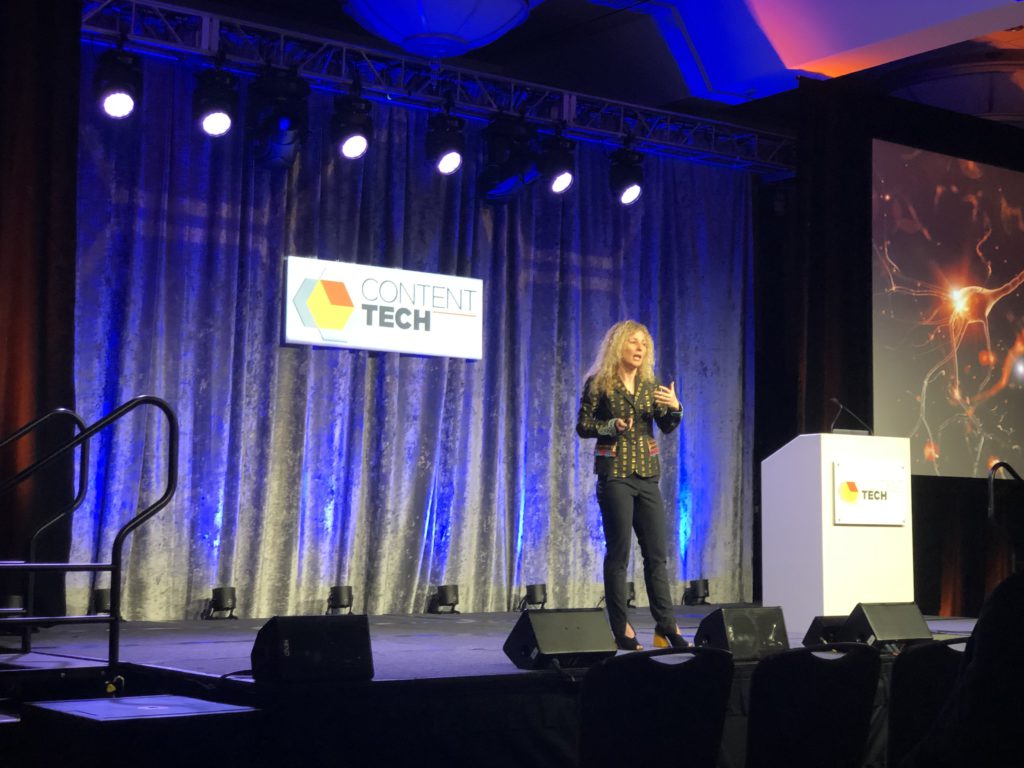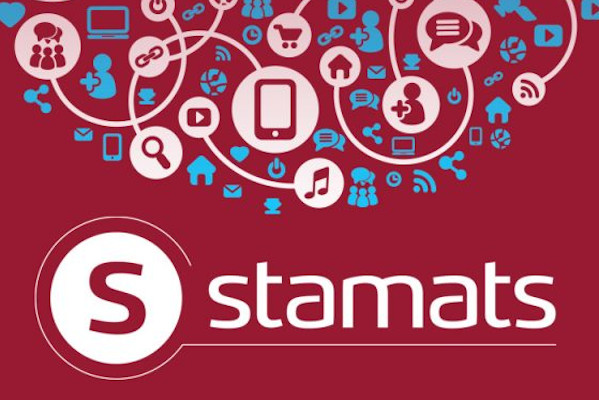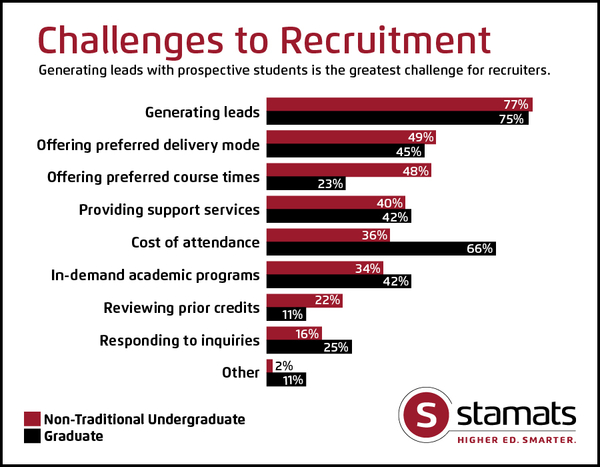Jared Johnson, a top 100 digital heclealth influencer, podcaster and keynote speaker who spent his entire 16-year career in healthcare and education joins us to discuss the benefits, when to centralize the brand message, and managing expectations.
Read the full transcript
Mariah: I’m Mariah Obiedzinski, director of content services at Stamats. Joining me today is Jared Johnson, a Top 100 Digital Health Influencer, podcaster, and keynote speaker who spent his entire 16-year career in healthcare and education. Welcome, Jared.
Jared: Thank you, Mariah.
Mariah: Today we’re discussing how medical schools can join forces with active social media leaders from within their organizations to grow the school’s brand and encourage more active, relevant engagement across multiple audiences.
Jared, in higher education, many administrators, residents, and students are active in social media and blogging, some even to influencer-level, which means they have a following of individuals that actively engage with their personal brand.
What are some of the benefits of leveraging those efforts of these individual influencers to affect the organizational brand?
Jared: Well, Mariah, I think there are several benefits. Some of them are direct and some are a little more indirect. But they all have a positive outcome on the brand. And the first one of those is simply building and increasing the digital footprint of the organization, of the institution.
And the way that happens is, at the end of the day, there’s only so much that the institution itself can do to build its own footprint online. And we all understand what that means, I feel like. There’s only so much posting on social media and blogging and putting web content out there, that the organization itself can do.
What we’re all faced with these days is a general trust gap between an organization, their brand, and people out there who are consuming that content online. And so, to help overcome that trust gap, the more that somebody who’s part of the institution themselves is producing content, that kind of has a voice and a presence out there online and is creating conversations and content themselves, whether it be on a social media channel specifically or blog, I guess we can kind of use those things interchangeably, but the more individuals together that do that, that lifts the brand itself, because it’s kind of the long-tail of search, right?
You’re going to get a lot more people searching for the institution and somebody who says, “These tweets are my own,” that they’re still a member of the institution or attending it. Those individuals are going to overall combine for a much greater impact online. So, I guess the first thing is increasing that digital footprint.
The second one has in my mind is just as important and just as powerful, it’s the impact on the individuals themselves. In higher ed especially (we’re talking medical schools, for instance) there’s a lot going on for the students, for those attending themselves. And so, a lot of times, a way for them to kind of help themselves get through it is to put some thoughts out there, and just tell how they’re feeling, and sharing what they’re doing on social media.
For the institution to support that indirectly shows the students who are attending that the organization supports them as people and not just as students. And it sends a signal to them that, “We’re interested in you,” and indirectly that helps them succeed and feel like the institution really does care.
It’s the same as a teacher in class going outside of class, in my mind, to get to know their students a little bit. And not just talk shop, not just talk about assignments or whatever, but to get to know them a little bit, or what they’re interested in.
We all have experienced that ourselves, or with our families and our children. You know what a difference that makes to the child when a teacher goes out of their way to build a relationship in a slightly different way, to go above and beyond.
To me, this is the institutional version of that. And so, what that does is that empowers the students themselves to feel like they are a part of something special, because the organization supports them.
What all that does, Mariah, together, when that combines together, is that strengthens the brand of the organization because you don’t have to go out and create a word-of-mouth strategy – because people are already doing that for you. So, there are a lot of different benefits. I guess those are the couple that I’d focus on first and foremost.
Mariah: Yeah. That’s really interesting that you bring up the kind of burnout sort of topic. We hear about that a lot in healthcare, in the physician burnout world. But sometimes we forget that medical students are under just as much pressure, if not more, than physicians out there in the field.
So, really, like you mentioned, giving that impression and giving that warm feeling that they care and that they want to vocalize these issues and pay attention provides that empathetic vibe that you can’t necessarily get in an ad or a digital placement somewhere. A little bit more personal.
How can medical schools really connect their organizational brand and content marketing efforts in a relevant way with the digital engagement of these influencers and vice versa?
Jared: That’s a great question. And there’s a lot to it. I would say just some first steps are to be, first and foremost, be aware of those who are attending your institutionand out there blogging or posting on any social media channel.And there are a lot of different platforms. We don’t have to go into them too much. But find a platform, if you don’t have one already, that helps you monitor and go out and search for those who are attending.
Because a lot of times, they’re not going to be mentioning the institution by name in their posts. So, you want to find a platform that helps you be able to find it essentially in their bios. A lot of times they will say on their Instagram, for instance, that, “I’m a third-year at such-and-such university med school.” You know, “I’m a resident at such-and-such institution.” And a lot of times that’s in the bios. A lot of times that might be in a post itself.
That can take a while, but that’s a really important step is to go out and see how many you can find. You might not find all of them, but going out, doing some basic searches with the right software will help you find who they are. And then you start just spending some time looking at what they’re talking about.
I’m telling you, it can be overwhelming because especially for a large institution where there are thousands or even tens-of-thousands attending potentially. It’ll be a little easier to scale for a smaller organization. But commit some time to identify and engage with those who are attending and are posting and already trying to establish themselves on social media.
That’s the best thing you can do to start off with. Because then it’s natural to, as you’re monitoring them, to start following them, to share, to like, to engage with their posts. And then you’re extending what we just talked about with the first question in terms of showing your support for them.
So, really, I think that’s the first step is just recognizing that they’re out there. We usually talk a lot about online reputation with anything that we’re doing. Well, we usually say things like, “People are talking about us and our brands anyway, whether we’re monitoring them or not. Whether we’re engaging with them or not.” Well, the same thing holds true for those who are part of our institution, so our staff and our students.
So, what we really want to keep an eye on is, like I said, first and foremost, just finding them. But secondly, being aware of the types of things that they’re saying. Best case is that you have a handful, not a lot; best case is there are a few out there that are just naturally, organically waving the flag, holding up their testimonial of the institution, and praising the institution itself and saying how great it is to be a student here.
I don’t think a lot of people do that from what I see, not naturally. But it’s indirect. So, that’s a good first step, just to figure out who they are. Keep track, follow them, and engage with them and show them some support.
Mariah: I couldn’t agree more. That leg work—let’s not kid ourselves, it’s a lot of work, especially like you mentioned when there’s thousands and thousands of students across all the departments. But it is so important because you’re forging those relationships right away as a student, as a resident, and so forth. And then that can potentially carry over long past when they’re done, and they can continue to be an influencer for you, sharing your content because they remember that great experience.
How do these departments that share some dependencies when it comes to marketing and strategy really collaborate? What are your thoughts on centralizing content versus decentralizing it?
Jared: Well, I’m going to say “yes” to both. I think this isn’t an all-inclusive answer one way or the other. There are some elements of both I feel like are necessary to succeed here. The closest to this, we’re talking about lots of different departments.
So, in my time at Phoenix Children’s Hospital, there were 125 subspecialties there. And our team was charged with monitoring all of those and centralizing our content strategy, which included all of our social. And that was a task because the centralized portion, what you quickly find is that if you try to go completely centralized, most of the time you’re not actually meeting the content needs of those individual departments. So, what you want to talk about isn’t what a lot of them want to talk about.
It’s dangerous to try to go fully centralized because then you’re going to dilute the brand voice itself in what you’re saying. And any individual department might say, “Yeah. We don’t really care about that at all.” And so, you have to have an element of a decentralization in your strategy to really still keep those individual voices in it.
And what I’ve found successful is, at least to start off with as part of your editorial calendar, have a rotation through some of those departments that are kind of the more low-hanging fruit, or the louder voices that are out there trying to post already. A lot of times, they may have their own account somewhere. They may be posting. They may have a Facebook group. They may have an Instagram or whatever else. They may have their own blog that they’re up and running themselves.
So, while you’re deciding how centralized to be with those voices, start off by rotating through them on that centralized channel that you’ve got. And that at least gives you a better idea of what they’re posting about, what they care about.
Because, at the end of the day, everything is about what they care about. It’s not about what you as your brand care about. I mean, that’s part of it. But there’s still enough of an individual voice out there that you have to think of both.
I’ll give you an example. There’s at one point, there were, like I said, there were 125 subspecialties at Phoenix Children’s. And one of them, you know, the radiology department, came once and asked if they could start their own Instagram. And initially—this is a great example of how centralization/decentralization kind of both were at odds at first—because we thought well, we have a separate physician-facing, provider-facing content strategy.
And Instagram to that point hadn’t been part of it. We had a main account for Phoenix Children’s for the hospital that, in this case, it turned out it was a bit of a diluted voice out there. It was pretty generic content. It was focused on patient stories. So, for that it was good. We had a lot of nurses and staff engaging with the main account.
But when it came time for the radiology team to come, they had a resident who was insistent that they were going to be posting all the time. Because that was usually the concern—just about every department-specific account up to that point had a short shelf life. The pipeline just dried up really quickly within 1 to 3 months, I would say. And we wanted to make sure that we felt that out with them, and they said, “No, really. We can prove it to you.” And we said, “OK. We’ll do a pilot period with you guys.”
And my initial thoughts were very, very wrong it turned out. I wondered how much of a shelf life a radiology account can have on Instagram. They grew that thing so quickly—they hit 12,000 followers on there. Before we knew it, they were surpassing the hospital’s following on the radiology account. And it’s to this day, it’s still growing insanely. And they are posting every day, and they are getting tons of engagement, which first and foremost, told me that, wow. I better open my eyes because, even when I think I know what I’m talking about, I better open my eyes to how quickly things change and how many healthcare professionals in their case, and providers specifically—clinicians of all types were on Instagram engaging with case films and they had been properly deidentified. Everything on there was just—it was unbelievable.
Just an example of when we wanted to be more centralized with it and our team had taken pride actually in being able to kind of shut down some of those other accounts that had been created by other departments but had kind of dried up. Here we had one that was doing the exact opposite and was just putting the main hospital Instagram to shame.
So, if you have somebody like that who knows what they’re doing and they’re going to do it one way or the other, find a way to work with the demand recognize— what we would do is on the main Instagram account, we’d start sharing a lot of those radiology posts, even though that wasn’t part of the initial content strategy, because we wanted to cross-pollinate a little bit and just see how much of the audience was looking at both.
Turns out it was a pretty different audience. And so, after a little bit, we didn’t do that anymore on the main hospital account. Just goes to show you, it’s a complicated question.
Mariah: Yeah. Absolutely. And you bring up kind of a finer point that a lot of our audience probably can relate to, as sometimes marketing gets that big bad, “Oh, here comes marketing. They’re going to come and shut us down.”
But I think as we approach more of the digital initiatives and really try to, like you said, cross-pollinate, go across and get that cohesive strategy in higher ed and especially in medical schools, we really need to be a collaborative resource for one another and support and cheerlead more than just say, “No, no, no,” every time.
How can those medical schools really determine and implement what content can be cohesively strategized and shared across the board?
Jared: That is a really good question because that’s kind of the next step. So, as you’ve taken the first couple of steps, as you’ve gotten familiar with who’s out there already and sharing their voices and gotten a better idea of what content can be centralized and what really needs to stay in those individual voices, then really that next step is to keep all of those elements in your content strategy.
And that’s another one that’s really easy to talk about, I feel like, and really difficult to implement. Especially the larger the institution is. The more departments, the more different teams are involved, especially with more diversity of age groups within the team, everyone’s going to have a different preference on which medium or channel they’re gonna gravitate towards anyway.
So, that’s a good example of some, where you can almost tell, I don’t want to stereotype it either, but the fact is there’s a lot of times you can tell just what our go-to social media channel is. A lot of times you can link that to a general generation or age group that you apply to.
And so, just knowing that, knowing what those kinds of conflicts are going to be or at least those kinds of different questions and approaches are going to pop up, those are important considerations. Because a lot of times what we do want to do—I love what you just highlighted there and pointed out, the part of just how we can kind of get a bad repin the marketing or branding teams. And there’s a legitimate reason why, because ultimately those teams are responsible for protecting and maintaining and growing a brand.
Well, I like to follow what my friend, Aaron Watkins, who leads digital for Johns Hopkins Medicine, what he has said on numerous occasions. From his experience, he has highlighted how it’s very difficult to be seen internally with your stakeholders as a governor and an innovator at the same time.
So, how that applies to this is if the reputation internally is, “Here comes marketing. They’re going to shut us down because that’s what they always do,” the last thing they’re going to do is work with us when they do have an innovative idea or they do want to launch a new account, when they do want to try something different, and that type of experimentation is important. It’s essential, actually, to keeping up with how we’re all consuming information online.
So, we don’t want to discourage that. The more internal stakeholders and a lot of cases, this is going to be staff and students, as they see us as that governor, the ones that are gonna shut them down, we’re the last ones they’re going to come to for support. They’re actually just going to go launch the account on their own and they’re going kinda basically do it as a rogue account.
And so, honestly, one of the main ways to answer your question of just how to implement this strategy, how to lead it and centralize it from the school of medicine, from the institution, is to be aware that those types of things may happen. And so, half of it is just how they approach it with those who they want to be part of their strategy. If that makes sense.
You know, there’s going to be a certain amount of students who are out there and very active already, and we want to, I’ve always wanted to encourage that because, at the end of the day, it’s a lot easier to encourage that content from others and guide it a little bit if needed, then try to get people who aren’t already used to sharing content and creating their own voice to do so.
It’s almost impossible to get somebody who’s just not used to putting stuff out there to start doing that. So, I’d much rather guide it and encourage it. And to me, that has been the main challenge in creating a strategy.
Because otherwise you’re going to be there with the institution’s marketing team itself coming up with a strategy, and if you’re not involving those who are going to be part of it in the planning process, then they’re not going to care what your process is. It’s kind of like trying to plan a digital health platform without asking patients what they want. Do they actually care about what that innovation is?
So, we just have to be careful. I think you can kind of sum all that up by saying the collaboration internally is essential there. And how we approach it with those who we want to be involved is as important as anything.
Mariah: Exactly. And you highlighted a really great example with the radiology program there at Phoenix Children’s of really managing those expectations. How often are you going to post? What are your growth metrics that you’re looking at and so forth? And that really brings us to kind of the next step of once you decide on a strategy.
How can both the medical school marketers and the individuals that are responsible for posting and for creating that content or curating, really manage the expectations internally and with leadership and stakeholders?
Because, both of us know and everybody listening knows, that most marketing efforts, those big wins are not going to happen overnight.
Jared: They most definitely aren’t. And I think making the timeline a main aspect of any expectations is key. So, conveying that right off the bat that, I have a friend, Dr. Justin Smith who leads digital health at Cook Children’s hospital in Fort Worth, TX.
He’s a genuine thought leader for clinical leadership, especially pediatric leadership. And he really got institutional buy-in to lead that himself. He’s prolific on Twitter. He’s a prolific blogger. He’s always out there asking and answering questions. And he told me, he and I walked through a lot about the expectations that were for his team. Basically, he started a podcast about pediatric leadership for clinicians.
They wanted to establish Children’s as a leader. And I’m sure part of that had to do with recruitment from institutions. And so, the expectation was…it was really funny because he had a really good podcast. And I believe it was once a week. And within like a month, he was saying, “You know what? Leadership is asking what’s the result of it.” And I’m like, “It’s only been a month.” He’s like, “I can count on one hand how many episodes I’ve put out there, and they’re already asking me, ‘What are the results? What’s going to happen? Are we getting more patients? Are we recruiting better physicians? Or what?’” And he’s like, “Man.” He had tried to set the expectations and it was still a challenge.
I think a lot of times we just have to think, at the end of the day, do our stakeholders, do our leaders, see it as us just kind of playing around out there? And I think we always have to constantly communicate the business value of thought leadership, of being on social media and blogs and other online content.
We have to constantly beat that drum and remind everyone of the business content and the business value of that. Because if we don’t, we may have set technically, and as I recall, I’m pretty sure Dr. Smith even said this, “We set all these expectations up from the beginning. And I’m still having to answer these same questions and a month into it, they’re still asking me, ‘Hey, so, how has this moved the needle?’” And he was like, “We’ve been talking about this all the time. I’ll remind you. This isn’t going to move the needle in that short amount of time. Here are our specific goals, here are our objectives,” and so forth.
It’s just another indicator, really, of even though technically we may have set those expectations once, I think a key to making sure they’re understood is continually bringing them up at the right, opportune moments to remind everyone. “Just so you know, remember what we said when we got started. This will hopefully move the needle in these ways. But look, we have to get six months into this, we have to get 12 months into this. And you guys gave us the leeway to do that, and we are running with it. And we are succeeding here and here and here.” It’s just a lot more intentional sharing of that information with our leaders and stakeholders than we might think initially.
Mariah: It’s really going to be interesting over the next 5 to 10 years as more millennials and then the digital native groups come in and start assuming these position roles from medical school, and start assuming these administrative roles, to see how that will change. Because I think, as we highlighted, the different age groups use different platforms and have, sometimes, different understandings of how long things take or different expectations of what viral is and all of those other fun things that we encounter day-to-day in the higher ed marketing space. But yes. I’m really looking forward to seeing how that changes and how that collaboration will flex as well.
How can these organizations and individual influencers really measure their success? What metrics do you typically recommend that people look at, short-term and long-term?
Jared: So, there are a couple different schools of thought here. One is that take someone who’s attending, so a student at a medical school. So, that student might be buried in the actual course work itself, but it’s crazy. It shouldn’t be so crazy, but it feels crazy still. Just recently, I’ve been looking at just how many medical students are on Instagram with fashion—all they’re posting about is basically fashion. And maybe it’s just one group that I found that are all kind of connected to each other. But they’re not—they’ll be one every now and then wearing a white coat. But almost everything else with them, on their off time, this is who they are when they’re not having their nose in a book studying and cramming for exams and attending their clinicals and so forth. They’re showing who they are.
How they measure that success is one of two ways. They’re either going to be happy with the fact that they can share who they are online and share ideas with people. And for a lot of them, that’s all they want to do it for. When we start talking about influencers, they are dead set on growing their follower base, their followers or fans, those who “like” them. And they’re dead set on being an influencer in the space in addition to everything else.
So, they’re going to measure their success primarily by their follower base and their engagement. I know people who will post and, if they don’t get a certain number of “likes,” they’ll actually delete the post off Instagram because they don’t want to be seen as not having a lot of engagement.
To me, that’s a little extreme, but I think that’s the mind of an influencer. They see people are seeing them and saying, “Oh, well if they were any good, they’d have more followers or they’d have more likes, they’d have more comments.” And that’s literally just the world they live in.
And so, you have to put that mindset on to realize, no matter what we say, that’s how they’re going to measure themselves because that’s how they see themselves—literally as influencers.
On the organizational side, it is a combination of that. I tend to think impressions and followers are good. They’re still a primary metric, but they’re not the first one I’d look at. The first one I always look at with anything to do with social media is engagement rate over total engagement. Or engagement rate per post, because that tells me on an individual basis how much people engage with what I’m putting out there.
Now, total engagement is a good way to measure that, too, because if you just look at one of these metrics over the other, then there’s easy ways to do it. If you only want total engagement, then you just post more. Ultimately, you’re just going to do that. But you can’t—it’s really hard to measure how many people you annoyed by flooding their stream all day long with just you.
So, that’s a lot harder to measure. But with the total engagement, it might look like it’s a great metric. So, I’m always cautious about only using total engagement or total followers because those things do help. They help you gauge where you are compared to others. But on their own, it’s easy to use those figures.
So, if you have engagement rate per post as one of your metrics, at the very least, you’re going to recognize the trends that are based on what type of content you’re putting out there, what types of posts, how often, what time of day, all those kinds of things that we like to kind of fret about. It’s a lot easier to see that by the engagement rate per post.
We probably haven’t covered that, but that’s just simply the engagements for that particular post over the number of impressions or reach for that post. It’s a percentage, it’s usually—it varies by channel, but it can be anywhere from 1 to 3 to 5 to 10 percent depending on the channel. Anywhere in that can actually be considered a really strong engagement rate. Anything higher than that, almost any channel, is going to be significant.
So, those are at least base figures. So, I would come back to that. Engagement rate and then total engagement and number of followers just as reference, but not typically the key thing I would focus on.
Mariah: And I’m with you. I am a huge proponent of watching trends. So, it’s good to get down to that granular level once and a while. And I see agencies—and it gives me hives, to be honest with you—I see agencies go all the way down with their clients or even organizations, “We got X number of smiley faces versus hearts on this post.” Or “We got this versus that.”
And sometimes that’s okay to look at. Sometimes it’s entertaining to look at. But what does the number of hearts or smiley faces or angry faces on a post, one post looking at it singularly, really tell you? It doesn’t tell you much. And so, you really have to look, like you said, in a global way. Look at all these metrics across and how they relate to each other and not parse it down to, “We’re going to look at just this one thing and judge our success by that.”
Jared: I was just going to agree with you, Mariah. Because I feel like, especially in an academic institution, a lot of times, a single—it would be extremely rare for a single post anywhere, whether it’s a paid or boosted or organic post, to influence somebody on its own to attend that institution. It might be one of 20 or 30 touch points that all together influenced somebody and gave them something else to think about and come into play.
So, in my mind, a lot of social media engagement is a branding play, not necessarily a direct marketing play. If it is, then the metrics are a little different. And you are going to focus more directly on clicks and conversions and so forth. That tends not to be the case as much with academic institutions.
Although there has been an increase on say, like, Instagram swipe up ads for that to become an increasing way to get people at least contacting the institution or clicking through. It is on the rise. It’s just there’s a lot of confusion that way when explaining what the value ultimately is of the effort put into these channels.
Mariah: And that’s definitely one of those intersections where the things that the stakeholders care about and the things that the marketing teams care about. Because you’re looking at all of this data—everything in a medical school is data driven, everything in a healthcare organization is data driven, and it should be the same in marketing. And I think, as a unit, as an industry, we’re really getting there and really expecting that to be a best practice.
Keeping that in mind, along with that total broad look at metrics and not just becoming extremely granular, what are some of those key components of successful content marketing, in any platform, the measurement of it and how can schools set up a model to govern that process and keep that constant publication and review ongoing?
Jared: That’s a really good question. I think the biggest thing for me is just constantly having enough in the pipeline and knowing who you’re pleasing with the content. So, especially in an academic institution, especially in a medical school, you’re dealing with a lot—healthcare professionals a lot of times, especially tenured ones, are very strongly opinionated. This is not news to anyone. I’m not breaking news here.
But that comes into play with how we explain to them the value of the time that we’re working on. And how we say, “You want me to post that here. This isn’t the best place for that, because here’s our goal for that channel.” So, really, it sounds simple, but it’s one of those things that Content Marketing Institute and other institutions just keep driving into people is that the majority of organizations do not have a documented content strategy.
I love Cleveland Clinic’s content strategy. It’s one sentence and it has been one sentence for their Health Essentials blog, ever since Amanda Todorovich has been there for six years now. It hasn’t changed. And it’s one sentence. And it’s something along the lines of just providing useful, relevant, unique healthcare content to make healthcare and wellness better for people. You know, it’s something generic like that.
But that’s their north star. They can always point to it and say, “Here’s the reason why what you’re asking me to do, to post, doesn’t quite fit that. We do have an alternative for that. We’ve got this Twitter account. We’ve got this other place where we will put it. But, just so you know, that’s why that doesn’t fit into this stream.” So, you have to think about how it helps you kind of defend against the rogue requests. And, like I said, in a medical institution, you’re going to get a lot of them.
So, that’s one of the keys to success in how to set up your model, is to be aware of that and to have your documented strategy. It’s typically a lot more useful—like I said, that was for Cleveland Clinic, just for their Health Essentials blog. For their social media channels, they have different strategies. Now, if I’ve heard correctly, they’re pretty simple as well. They’re not detailed, long strategies, but they’re different for each channel.
If you can’t provide that for somebody and say in one to two sentences for each of your social channels and other areas where you’re creating content, what the purpose is and who you are trying to affect some kind of change in, if you can’t provide that, then you’re going to have a really hard time defending against people who insist, “No, you have to post this somewhere.” And you know what that does.
That’s just like a block in the road, like all the traffic has to stop. All the traffic you’ve been trying to get lined up in your pipeline and maintain that, it all just goes out the window. Then people insist on putting other stuff in there. And you know it’s going to clutter up your feed, and you know that’s not what the audience that you’ve cultivated so hard wants to read about or watch or whatever.
Mariah: So, it’s really the antithesis of what they’ve been talking about at that Content Marketing Institute for the last couple of years. You don’t want to be disruptive. You want to go in, and you want to be very relevant and very naturalwith your audience.
Jared: Yes. Exactly. And so, it’s always a shame when it happens, but it happens a lot, more than we probably hear about. And maybe it’s just because it seems like such a simple thing to document your strategy. But that also helps a lot of times in the day-to-day decisions. It’s a lot easier to plan out three months, six months out of posts or content when you know what your cadence is and what your goal is, and what the topics are that far in advance. If you just say, “Look. This is what we’re going to stick with. We’re not gonna keep changing it based on who’s asking us to do things.”
So, really, I see that as just, like I said, a simple, easy thing to do. But take the time to do it now rather than later. It saves you now and it saves you down the road. Besides that, in terms of how to just set up that model and process going forward, just being clear, putting yourselves in your stakeholders’ shoes.
So, if you’re on the organizational team and you have connected with some of the thought leaders who are attending your institution and they want to know, like, “Okay, hey. We’re on board with your content strategy. We want to help. We want to amplify some of your content.” They probably won’t say it that way. That’s just how marketers say it. “Amplify some of your stuff.” They’ll be like, “Hey that’s cool. We’ll share some of that.”
If they’re on board, then put yourselves in their shoes. They want things to be really easy for them. They’re not going to go out of their way to share something about the institution, even if it is cool and they agree with it. If you make that easy for them and you are regularly tagging them with your content, those are ways to build bridges with the thought leaders within your institution. So, they can keep on doing their own thing, but then you make it easier for them to, every now and then, just drop in something that you would like them to share about the institution.
Anyway, you just make it easy for them. Just knowing that social media these days for somebody who’s not on the organizational team—they’re spending a lot more time consuming it than they are trying to figure out on a day-to-day basis what to post.
So, put yourself in their shoes. Know what they would like and what makes it easy for them to share things that have to do with our strategy. The more we do that, the easier it will be, and each thought leader that you have out there on your behalf is part of that long-tail of content, kind of coming back to the one of the first things we were talking about. It’s the more touch points you have out there that really does build your brand and just makes it easier and more valuable at the end of the day for everything that you’re doing.
Mariah: Oh, absolutely. And something that I’d like to highlight that you just mentioned, too, is when you really know your audience, and you really know what they want, when they want it, and in what format, there’s absolutely nothing wrong with—and it’s actually encouraged—to plan that content out a few months in advance. You said up to 6 months or so. That’s a really good way to make sure you have something that’s always in the queue.
And if you have that basic understanding, and you have that format you’re going for in the right platform, you can make it very much more manageable. And you can go in and do those daily or weekly checks. Okay, is everything still aligned with what we want to be saying today and what’s going on in the climate of the school, and politically and so forth, to make your message consistent without having to rush in every morning and get everything lined up, because it’s already there?
So, what would a couple of closing remarks from you be?
What would you like to leave for key words of advice for individuals at medical schools who are responsible for content marketing and engagement with that staff and student influencer body?
Jared: I think I would just look at again, putting ourselves in our students’ shoes. What’s on their minds? It’s probably not, “How can I increase the institution’s brand?” They’re just concerned with making it day-to-day. They are studying 14 to 16 to 18 hours a day, maybe more. And they’re intent on what their goal is. They’re likely very goal-oriented people to be where they are. But at the same time, they’ve heard that the medicine that they’re going into is different than the medicine that, if their parents went into it, it’s different than the medical field that their parents went into. And they’re trying to make sense of it all.
In most cases, it’s a young adult trying to find out and make sense of everything. At the same time, they’re being thrust into interesting financial situations. They’re taking on six figures worth of debt. So, anything you can do that showcases who they are and humanizes your strategy for them and including them, that shows that you do support them as people, will go so much farther to strengthen your brand with those individuals.
It doesn’t have to be a push-pull, an adversarial relationship, with them. Don’t come in saying that you’re the brand police and that it’s your job to shut them down and tell them what they can and can’t say. Provide some guidelines that still, at the end of the day, show, “Hey, we encourage you. We want your voice out there. We like the ideas you have out there. We’re glad you’re connecting those with other people’s ideas.” And encourage them, help them see the value of creating a network.
My goodness, I don’t know where I’d be today in my career without the network connections that I have and what I’ve learned from other people. And those relationships that have developed from, with other people and a lot of times, especially the last three to five years, that has really come a lot through social media engagement. And then when I do meet somebody in person at a conference or something, it’s like, “Oh my gosh.” We can’t even remember if we have met in person before because we engage so much in between.
Mariah: Absolutely. That’s where you and I met. We met in the land of Twitter of LinkedIn.
Jared: Right. Right. That’s true. And it was just one of those—you know each other when you do see each other in real life, and it’s like, “Man. This is really cool.” This is just kind of how it is these days.
So, just being aware of a lot of these things that are going to drive a lot of growth and development in our content strategies. It doesn’t have to be us versus them. We really can encourage those ideas. Just think how far that goes for us as employees anywhere we work, where we are shown by our boss (or anyone) that they get where we’re coming from and they support our ideas. It’s the same thing. See them that way and see them as assets to your organization. And then you don’t have to give them all these rules and regulations of how to act online. They’ll just do it naturally.
Mariah: I think that is especially applicable in the medical school setting because, chances are, these individuals are going to “grow up” and maybe come and work for your system. Maybe come and work for your medical school or the associated hospital. So, really, including them in all of the successes, sharing that data with them, giving them that impetus to continue to do so, is extremely important and valuable.
Thank you so much, Jared, for sharing your expertise with us today. And again, it’s just so wonderful to have thoughtful and insightful individuals like you really advocating for the medical students out there, and the faculty and staff that work so hard to drum up that great networking opportunities for them and these great relationships.
Jared: Thanks again for the opportunity. Yeah. I really enjoy—you can probably tell—I really do believe in just the value of the types of relationships and the value that comes from just putting ourselves out there online and sharing who we are. It’s more valuable than a lot of times we realize.
Mariah: Absolutely. And thank you so much for listening today.
Ready to take on social? Contact us for a free strategy consultation.
Ready to Get Started?
Reach out to us to talk about your strategy and goals.











